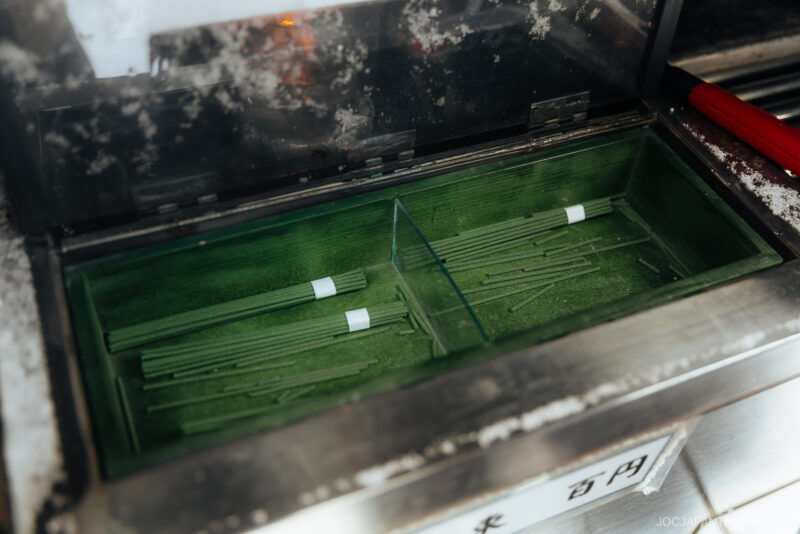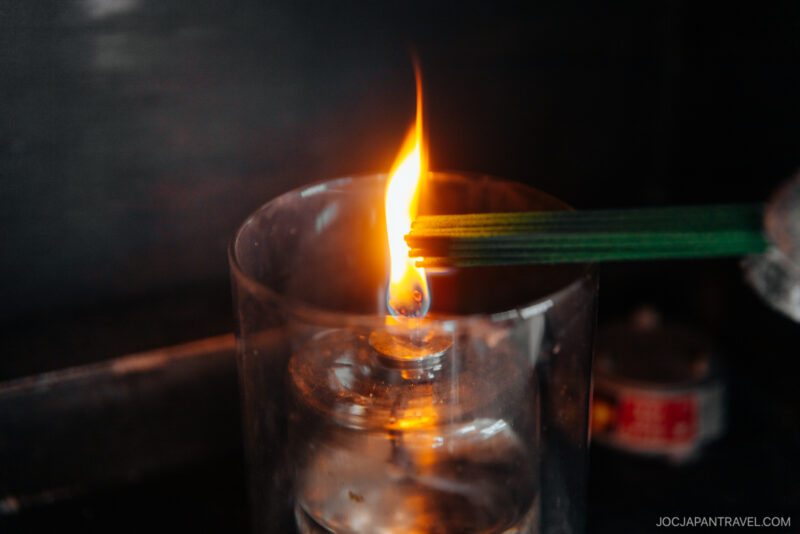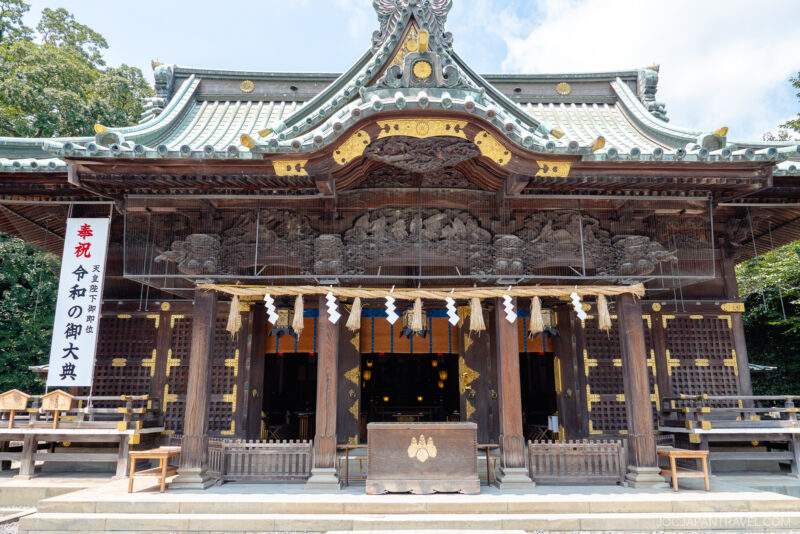This post may contain affiliate links. Please read our disclosure policy.
From the gentle ring of a temple bell to the graceful bow before a shrine, Japan’s sacred sites are filled with traditions that inspire peace and wonder. Let’s explore their stories, customs, and etiquette together.

While traveling in Japan, you’ll encounter countless shrines and temples in all shapes and sizes. In December 2019, the Agency for Cultural Affairs reported roughly 84,000 Shinto shrines and 77,000 temples across the country.
Each plays an important role in Japan’s history and culture, which can make it daunting to understand the differences and know how to show respect, especially if you didn’t grow up in Japan and aren’t familiar with the religious background. To make things trickier, shrines and temples have different etiquette!
In this post, we’ll guide you through everything you need to know: the differences between shrines and temples, a step-by-step visiting guide, and more. First, let’s look at the difference between Buddhism and Shintoism.
Buddhism and Shintoism

In contemporary Japan, there are two major religions: Buddhism and Shintoism.
Buddhism originated in India in the 6th century and was later introduced to Japan via China and Korea. Based on the teachings of Gautama Siddhartha, it has many sects, including Shingon, Pure Land, and the well-known Zen. Temples are where monks live, practice, and study Buddhism. In Japanese, temple names often end with -tera, -dera, or -ji. For example, Senso-ji in Asakusa and Todai-ji in Nara.
Shintoism, predating Buddhism in Japan, means “Way of the gods.” It teaches that kami (gods) inhabit everything—mountains, rivers, trees, and more. Shrines enshrine these kami or influential figures like emperors. Shrine names typically end in -jinja, -jingu, or -sha, such as Fushimi Inari Taisha in Kyoto and Meiji-Jingu in Tokyo.
What is the Difference Between a Shrine and a Temple

Shrines and temples in Japan can be distinguished by their unique appearance and distinctive layouts.
Temples are Buddhist sites. Their entrances often feature a sanmon gate with muscular Nio guardians on either side. Inside, you’ll find the garan (main hall and monks’ living quarters) with statues of Buddha for worship, as well as a pagoda and kondo (main hall) housing the temple’s treasures. Temples typically have tiled roofs with decorative ornaments on top.
Shrines are Shinto sites, marked by a torii gate—usually red—that separates the sacred from the human world. Stone komainu guardians and a temizuya (purification basin) often line the path. The honden (main sanctuary) houses the deity, which is usually hidden. Shrines favor natural materials, sometimes with thatched roofs, chigi (forked finials), and katsuogi (crossbars).
Knowing these features makes visiting Japan’s sacred sites more meaningful and easier to navigate.
Who Works at Shrines and Temples?

At temples, the staff are called monks or obosan. They perform Buddhist rituals, teach sutras, and maintain the temple’s spiritual practices.
At shrines, the staff are known as shinshoku or kannushi, who conduct rituals, handle administrative duties, and offer prayers. You may also see miko (shrine maidens) assisting with ceremonies, performances, and daily tasks around the shrine grounds.
Japanese Shrine Etiquette Tips

Shrine and temple etiquette vary slightly, so it is important to know the correct etiquette for each one.
- Upon reaching the torii gate entrance, slightly bow.
- Enter to the left or right of the center of the torii gate.
- Walk along the edge on the approach to the shrine.

- Head to the temizuya or chozuya to purify yourself. Here is a picture board of how to purify yourself.

- Pick up the ladle with your right hand and fill it with water. Wash your left hand.
- Then wash your right hand.
- Using your right hand, scoop some water and place it in your left hand. Rinse mouth.
- Wash your left hand again.
- Then, with both hands, raise the ladle and pour a small amount of water over it. (Check the photo below).
- At the main shrine, you will find an offering box. Put/throw a 5 yen coin in and ring the bell if the shrine has one. 5 yen is considered the lucky coin. However, a 1 or 10 yen coin is perfectly acceptable.

- Bow twice.

- Clap twice.

- With your hands together, make your prayer.

- After finishing your prayer, bow once more.
- When you leave the shrine, at the torii gate, turn around to the main hall and bow.

Japanese Temple Etiquette Tips
- At the sanmon entrance gate, bow slightly with your hands together. Step over the threshold of the gate.
- If the temple has one, head temizuya and purify yourself with the same method as the shrine.
- Purchase an incense.

- Light it with the designated lighter.

- Place in the incense burner and bow. Some people use their hands to spread the smoke over the body in wishes for good health and skin. Furthermore, do not use other people’s incense to burn yours, as it is said you will carry their sins.

- Go to the main hall and gently toss the coin into the offering box.

- If there is one, ring the bell two or three times.
- Bow slightly with your hands together and make your prayer. Do not clap.

- After finishing your prayer, bow again.
- When you leave the temple, at the sanmon, turn around to the main hall and bow.

What is Omikuji

After praying at a temple or shrine, you can pick up an omikuji (fortune paper) at one of the nearby stalls for 100 to 200 yen. Depending on the shrine or temple, there are different ways of picking your omikuji.
In some places, you can shake a tube until a stick with a number on the tip comes out. Then, you pick the omikuji in the drawer with your number.
Some other places are more straightforward, as you randomly take your omikuji out of a box.
Also known as a “message from god,” Omikuji tells you whether you have good or bad luck and more minor details such as money, health, relationships, and more. There are different types of fortune, which we will list below:
- Daikichi (大吉) – Great Fortune
- Chukichi (中吉) – Medium Blessing
- Shokichi (小吉) – Small Blessing
- Kichi (吉) – Blessing
- Hankichi (半吉) – Half Blessing
- Hankyoshi (末吉) – Blessing to Come
- Suetsukichi (末小吉) – Half Blessing to come
- Koshi (凶) – Misfortune
- Daikoshi (大凶) – Great misfortune

In Japan, people usually pick up their omikuji at the start of the year during hatsumode to see their fortune for the year. But you can try it anytime you visit a shrine or temple!
Many take their omikuji home, especially if it’s a good fortune, keeping it in their wallet or purse. If the fortune is bad, tradition calls for tying it to a pine tree. In Japanese, matsu (pine) sounds like matsu (to wait), symbolizing that the bad luck will wait at the tree instead of following you home. If there’s no pine, most shrines and temples have a dedicated rack for tying your omikuji.
Omamori – Good Luck Charms

Omamori, or Japanese good luck charms, come from the word mamoru (守る), meaning “to protect.” These small amulets usually contain a piece of paper or wood sealed inside an embroidered pouch and are believed to bring good luck or protection from misfortune.
There are also omamori for specific purposes—health, success, safety, and more. Shrines and temples take pride in their unique designs, so you’ll find something different at each location. Prices typically range from 500–1,000 yen.
Omamori come with a small string so you can attach them to a pencil case, wallet, or keychain. You can keep them as long as you like, though many in Japan renew theirs yearly. Old charms are returned to the shrine during hatsumode to be respectfully disposed of.
What is Ema for at Japanese Shrines

At shrines, you may notice small wooden plaques called ema, a Shinto custom for writing wishes. Prices usually range from 500–1,000 yen.
Pick up an ema at the shrine booth and write your wish with the provided pen. Some plaques feature artwork related to the shrine or its deity, while others are blank. Traditionally, you can add your name and address, as if your wish follows you home, though this is optional.
Experience the Spirit of Shrines and Temples
That’s a wrap on our guide to Japanese shrines and temples and how to tell them apart. While there’s much more to discover about Japan’s spiritual traditions, this guide gives you the essentials to explore and enjoy these sacred sites with confidence.
We’d love to hear from you. What’s your favorite shrine or temple in Japan, and what makes it special? Share your experiences in the comments!



